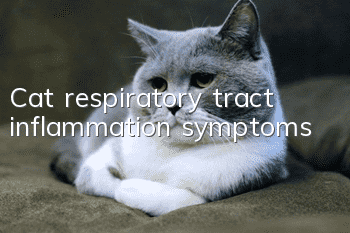Cat respiratory tract inflammation symptoms

The basic symptoms of upper respiratory tract infection in cats include sneezing, runny nose, nasal congestion, serous or purulent nasal discharge or eye secretions, conjunctivitis, lethargy, difficulty breathing, abnormal vocalizations, and when others have a cold. His voice changed when he spoke. Severe cases may cause fever, keratitis and even pneumonia.
Preventive measures for respiratory tract inflammation
1. When the weather is cold and humid, do not stay outdoors for too long. If you give your cat a bath in daily life, , you must also use a hair dryer to dry the cat completely to prevent colds.
2. Maintain environmental hygiene. Sleeping mats must be aired, cleaned and disinfected regularly. Avoid letting your cat's sleeping pad get damp, and don't let your cat sleep directly on a cold floor.
3. Close the doors and windows before going to bed at night to prevent drafts from blowing through. The diet should be balanced and nutritious, and the nutrients in the food should be strengthened to increase the body's resistance
- What should I do if my American shorthair cat has fleas?
- Why do cats keep opening their mouths and sticking out their tongues?
- British Shorthair female cat gill hair process
- What does it mean when a cat gently bites your hand?
- How to stop cats from scratching and biting?
- Why do Persian cats shed tears? Do you know the reasons?
- I regret owning a Bengal leopard cat
- What should I do if my cat doesn’t sleep at night? You can easily solve it by learning this trick!
- Can pregnant cats eat catnip?
- Analysis of ingredients of cat food and dog food



